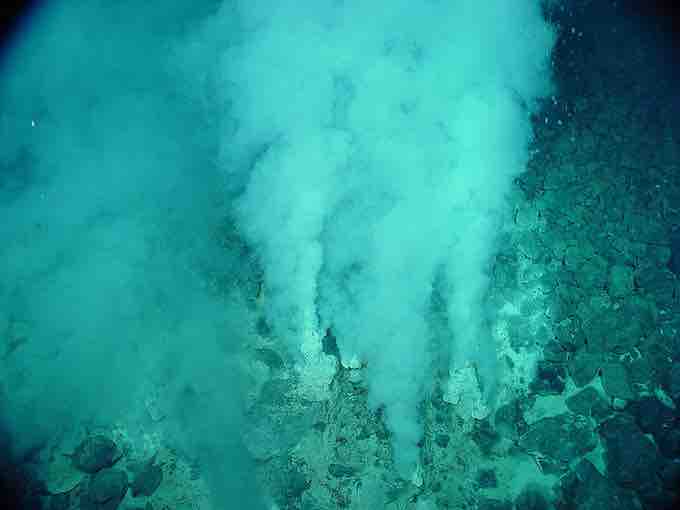The Aquificae phylum is a diverse collection of bacteria that live in harsh environmental settings. They have been found in hot springs, sulfur pools, and thermal ocean vents .

Aquificae habitat
White flocculent mats in and around the extremely gassy, high-temperature (>100°C, 212°F) white smokers at Champagne Vent.
Members of the genus Aquifex, for example, are productive in water between 85 to 95 °C. They are the dominant members of most terrestrial neutral-to-alkaline hot springs above 60 °C. They are autotrophs, and the primary carbon fixers in these environments. They are true bacteria (domain bacteria).
Comparative genomic studies have identified six conserved signature indels (CSIs) that are specific for the species from the phylum Aquificae and provide potential molecular markers for it. Along with Thermotogae, members of Aquificae are thermophilic eubacteria.
A 51 amino acid insertion has been identified in SecA preprotein translocase which is shared by various members of the phylum Aquificae as well as two Thermotogae species. The presence of the insertion in the Thermotogae species may be due to a horizontal gene transfer. In the 16S rRNA gene trees, the Aquificae species branch in the proximity of the phylum Thermotogae (another phylum comprising hyperthermophilic organisms) close to the archaeal-bacterial branch point. However, a close relationship of the Aquificae to Thermotogae, and the deep branching of Aquificae, is not supported by phylogenetic studies based upon other gene/protein sequences and also by conserved signature indels in several highly-conserved universal proteins.
The Aquificaceae family in the phylum Aquificae contains contains five genera, including Aquifex and Thermocrinis.
Aquifex is a genus of bacteria, one of the few in the phylum Aquificae. The two species generally classified in Aquifex are A. pyrophilus and A. aeolicus. Both are highly thermophilic, growing best in water temperature of 85 °C to 95 °C. Both known species are rod-shaped bacteria with a length of two to six µm and a diameter of around 0.5 µm. They are non-sporeforming, Gram-negative autotrophs. Aquifex means "water-maker" in Latin, and refers to the fact that its method of respiration creates water. They tend to form cell aggregates composed of up to one hundred individual cells. A. pyrophilus can even grow anaerobically by reducing nitrogen instead of oxygen. Like other thermophilic bacteria, Aquifex has important uses in industrial processes.
The genome of A. aeolicus has been successfully mapped. This was made easier by the fact that the length of the genome is only about a third of that for E. coli. Comparison of the A. aeolicus genome to other organisms showed that around 16% of its genes originated from the Archaea domain. Members of this genus are thought to be some of the earliest members of the eubacteria domain.
A. aeolicus was discovered north of Sicily, while A. pyrophilus was first found just north of Iceland. A. aeolicus is also known as one of the few bacterial species capable of doing gene silencing.